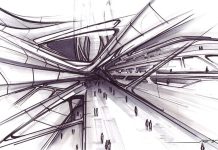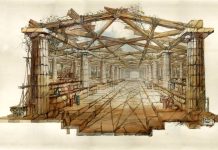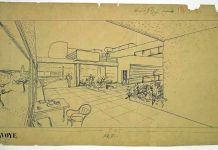Many buildings of the last two decades of the 20th century seemed to make their effect by means of fragmentation—they were structures that seemed about to topple over, or to break down conventional distinctions between up and down, left and right, inside and outside. These precarious-looking structures are often grouped together under the term deconstructivism. They are an endless source of visual, spatial and architectural stimulation.
The curious term “deconstructivism” seems to suggest an architecture that takes buildings apart. In fact the word has linguistic roots in two cultural movements. First of all, it is related to the deconstructionist movement in 1970s’ literary criticism, an attempt by literary scholars to take texts to pieces in order to excavate hidden meanings—meanings of which previous readers and even the authors of the texts were often quite unaware.
The second set of roots lies in the artistic movement called constructivism, which flourished in Russia in the 1920s. As well as being a type of architecture that embraced a particular kind of functionalist design, the Russian movement also involved design and painting, in which the paintings of El Lissitzky— which consisted of abstract arrangements of geometrical shapes and fragments—were especially prominent.
An architecture of fragmentation
Deconstructivism in architecture draws to a certain extent on both of these origins, but is very different from either. It creates buildings that often look fragmented, their parts and walls colliding at odd angles to produce odd, disjointed forms. Screens, beams, pillars and similar features create spaces that are half- inside, half-outside, so it is often difficult to tell where the boundaries of the structure are. The interiors often have an unusual sense of space, with odd angles and forms that challenge the traditional idea of a building as being full of rectangles.
The resulting sense of fragmentation in these buildings is sometimes influenced by Russian constructivist paintings, sometimes aims to analyze the building like a deconstructivist critic, but more often happens because of the specific vision of the architect.
Pivotal projects
When the movement was launched in 1988 at an exhibition at the Museum of Modern Art in New York, the catalog used terms such as dislocation, disruption, deflection and distortion to describe the type of buildings it would produce. At that point few deconstructivist buildings had actually been put up, but one exception was the adaptation of his own house the architect Frank Gehry undertook in 1977–78. The Gehry house turned from a simple bungalow into a bizarre structure fronted by additions that seem to recall sculptures made out of industrial materials such as mesh fencing, corrugated iron and concrete.
“Deconstructionist architecture … works best as an exception within a strong defined norm.”
Charles Jencks
Another built project, the series of pavilions (“Folies”) for the Parc de la Villette in Paris designed by Bernard Tschumi, also used a new and disorientating sense of space and form. But Tschumi gave the buildings a type of unity by drawing on 1920s constructivist machinery for inspiration and by painting all the pavilions a bright, vibrant red.
Building and meaning
Many have doubted that buildings can embody the type of linguistic philosophy that deconstructivism apparently draws on. How easy it is to assign “meaning” to these outwardly chaotic and bizarre buildings? In reply to this question, some architects, such as Bernard Tschumi, say that their buildings not only question the validity of conventional structures, but also reveal the fragmentation and disunity in modern culture. Another view sees buildings like the Gehry house (below) working in another way: their form can be viewed as offering a criticism of the more complacent designs generated by consumer society. Both views see deconstructivist architecture as embodying a radical alternative to the norm, and, as the architect and critic Charles Jencks has pointed out, this type of design is at its most powerful and relevant when it stands out as the exception to the rule.
Since then the various architects who have become known as deconstructivist have gone their separate ways, but many of them have made works with this sense of fragmentation. Frank Gehry has exploited computer design technology to create buildings, such as the famous Guggenheim Bilbao, that are all dramatic curves and reflections. Daniel Libeskind has used a new sense of space to symbolize the traumas of 20th-century history in his Jewish Museum, Berlin. The Viennese practice called Coop Himmelb(l)un has created an almost expressionist architecture out of deconstructivism’s radical fragmentation and juxtapositions. Peter Eisenman, adept at reinventing himself, has produced diverse buildings, but his NC Building, Tokyo (which looks as if it is about to collapse) and his Aronoff Center, New York (resembling a set of toppling boxes) have explored deconstructivism’s fascination with fragmentation.
Meanwhile one or two architects—notably Tschumi and Eisenman—continued to draw on the movement’s intellectual roots, Eisenman seeing his buildings in part as intellectual exercises to benefit a late 20th-century landscape from which any sense of place or identity was fast vanishing.
Deconstructivism stimulated architects in several ways. It provided a healthy reaction against cynical commercial skyscrapers, against the ultra-smooth surfaces of high-tech and against the sometimes facile designs of postmodernism. It offered fresh ways of defining space and of thinking about buildings in symbolic terms. And it provided excitement in a period when burgeoning market capitalism seemed to demand designs that were visually boring—from mirror-faced office blocks to identikit shop fronts. The movement is still influencing architecture in these beneficial ways, stimulating prominent architects such as Zaha Hadid and Rem Koolhaas whose search for new forms is continuous and exciting.




















